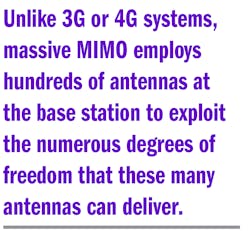Inside Track with James Kimery, Director of Product Marketing, RF Communications and SDR, National Instruments
This file type includes high-resolution graphics and schematics when applicable.
James Kimery is the director of marketing for RF, communications, and software-defined radio (SDR) initiatives at National Instruments (NI). He is responsible for the company’s communication system design and SDR strategies. Kimery also manages NI’s advanced research RF/Communications Lead User program.
5G is obviously receiving lots of attention. In your own words, can you tell us why we need 5G?
There are several reasons, but I believe that there are two primary drivers. First, we all know and have experienced the transformational impact of the smartphone. Our mobile smart devices have become an indispensable part of our lives and drive our collective demand for mobile broadband data, resulting in an exponential increase in broadband data. Unfortunately, industry analysts predict the growing demand for mobile data will outstrip capacity in the not-so-distant future. To keep up with rising demand, new capacity is needed. That’s where 5G comes in—5G promises significant increases in data rates and capacity.
Second, the concept of a network encompassing increased capacity, increased bandwidth, and perhaps even lower latency will inevitably give rise to a wealth of new applications and services that could transform our lives, once again spawning new businesses and unlocking enormous economic potential. Service operators are motivated to move 5G forward to increase revenue by offering new services for businesses and consumers beyond broadband data and voice, igniting an ecosystem of suppliers primed to deliver solutions that capitalize on these new capabilities.
To conclude, there are two primary drivers for 5G—one based on our need for faster data and more capacity than our current 4G networks, and the other rooted in the nascent wireless broadband movement but augmented by new 5G capabilities. The 5G network will enable entrepreneurs to create applications, services, and solutions that take full advantage of the network’s new functionality and hopefully create tremendous business opportunities.
Millimeter-wave frequencies are clearly tied to 5G. Where do you see that going?
On July 14, 2016, the FCC moved forward with reclassifying the following spectrum bands as mixed-use, including mobile access: 28-GHz (27.5 to 28.35 GHz), 37-GHz (37 to 38.6 GHz), and 39-GHz (38.6 to 40 GHz) bands, and a new unlicensed band at 64 to 71 GHz. In total, the FCC essentially allocated almost 14 GHz of licensed and unlicensed spectrum for 5G. As such, the United States became the first country in the world to designate spectrum for 5G operation and more aggressively designated specific centimeter-wave and millimeter-wave spectrum as potential spectrum targets.
Although these centimeter- and millimeter-wave frequencies have been designated for 5G by the U.S., global harmonization is a challenge. The WRC—the ITU group responsible for global spectrum harmonization—noted in 2015 that the 28-GHz band cannot by allocated globally, meaning the U.S. and other countries that have available spectrum around 28 GHz may likely join together to move asynchronously forward. Without global agreement on spectrum for 5G, worldwide acceptance and adoption of 5G technologies may be challenged.
In addition, the smartphone industry today enjoys tremendous benefits from economies of scale with the harmonization of the standard and spectrum bands regionally (and also technology with few vendors dominating the global market). 5G will need this type of harmonization to maximize the impact.
Furthermore, Verizon announced a “5G Specification” and plans for fixed wireless deployment intended for “last mile access” to residential homes. Although not technically 5G, Verizon has seen the opportunity and vision to move forward with millimeter-wave technologies to address a near-term opportunity. And this move could potentially pave the wave for a broader 5G millimeter-wave deployment for mobile access.
When we met at NIWeek, you mentioned how you think 5G’s modulation scheme may simply be orthogonal frequency-division multiplexing (OFDM). Do you still feel that’s the case?
Yes. In fact, since NIWeek, the 3GPP has kicked off several study items related to Release 15, otherwise known as the 5G release. Because the 3GPP is a consensus-building organization, OFDM seems to be the strongest candidate for Phase 1 5G standardization. Although competing waveforms are technically still alive and viable, OFDM seems to have the broadest support—and in a consensus organization, popularity matters. Other flavors of filtered OFDM are still being considered, but the path for inclusion is not quite as straightforward or clear.
Massive multiple-input, multiple-output (MIMO) technology is something that is linked to 5G. Can you tell us a little about it?
Unlike 3G or 4G systems, massive MIMO employs hundreds of antennas at the base station to exploit the numerous degrees of freedom that these many antennas can deliver. Lund University and the University of Bristol were able to demonstrate last spring the vast potential of massive MIMO by prototyping a 128-antenna system with 22 UEs. These researchers achieved a spectrum efficiency of over 145 b/s/Hz, which is over 15× the current LTE systems. Spectrum below 6 GHz is scarce, and by using massive MIMO rather than conventional LTE, networks could increase capacity by over 15× using relatively low-cost technology.
The 3GPP is still considering massive MIMO for inclusion in Release 15, and many aspects to massive MIMO must be worked out at a system level. However, there seems to be genuine interest and motivation to work through these issues and build consensus before June 2018, which is the current scheduled date for finalization of Phase 1 of 5G.
What challenges are associated with 5G testing?
These antenna beams are highly directional at such frequencies and may be packaged with the silicon, producing a module including the transceivers, low-noise amplifiers (LNAs), power amplifiers (PAs), and the antenna. With this type of packaging, instrument access with a cable is not possible and the specter of over-the-air testing of these modules must be considered. Over-the-air testing introduces many variables not encountered with cabled testing, and this is a research area for test-and-measurement companies.
Massive MIMO also presents challenges in that massive MIMO base stations feature hundreds of transceiver chains and MIMO processing, and these systems differ dramatically from current 4G implementations. With massive MIMO, each individual transceiver chain can be tested individually, but a test capable of testing all transceiver chains in aggregate is surely needed to obtain error-vector-magnitude (EVM) measurements—a common method to assess the performance characteristics of a transceiver. Testing one receiver or one transmit path is not sufficient to measure EVM of the system.
To address the massive MIMO test challenge, one could envision a signal generator with 128 or more outputs and a vector signal analyzer (VSA) with the same number. Cost-effectively delivering this type of instrument requires test-and-measurement companies to be creative.
What developments do you think will occur in 2017 that will bring 5G closer to reality?
Two really important events will happen in 2017. The work items for 3GPP Release 15 are expected to be set in March. So by March of 2017, we should have a good picture of the 5G Phase 1 specification, although there will be several months of work ahead for the 3GPP membership.
Second, I mentioned earlier the Verizon 5G specification. I believe there will be a big focus on what Verizon does in the 28-GHz band. Although Verizon may not deploy mobile access equipment, and perhaps the specification may be short of a comprehensive 5G mobile access network, the Verizon work will be the first commercial widespread deployment of centimeter-/millimeter-wave technology in the world. In some ways, the Verizon progress may be an early indicator of the success of 5G mobile access networks. In other words, if Verizon is successful with their field trials and deployments, this will bode well for future 5G millimeter-wave deployments.
Lastly, when do you expect to see the first 5G deployments?
The Korean government is pushing very hard to have 5G trial deployments in time for the 2018 Winter Olympics in Pyeoungchang, and these deployments are widely expected to be at 28 GHz. Given the timing of the specification finalization—June 2018—it is unclear whether these trial deployments will be standard-compliant. However, if both Verizon and the Korean operators such as Korea Telecom and South Korea Telecom are successful with their initial millimeter-wave deployment goals, then we may all see and experience 5G much sooner than 2020.




